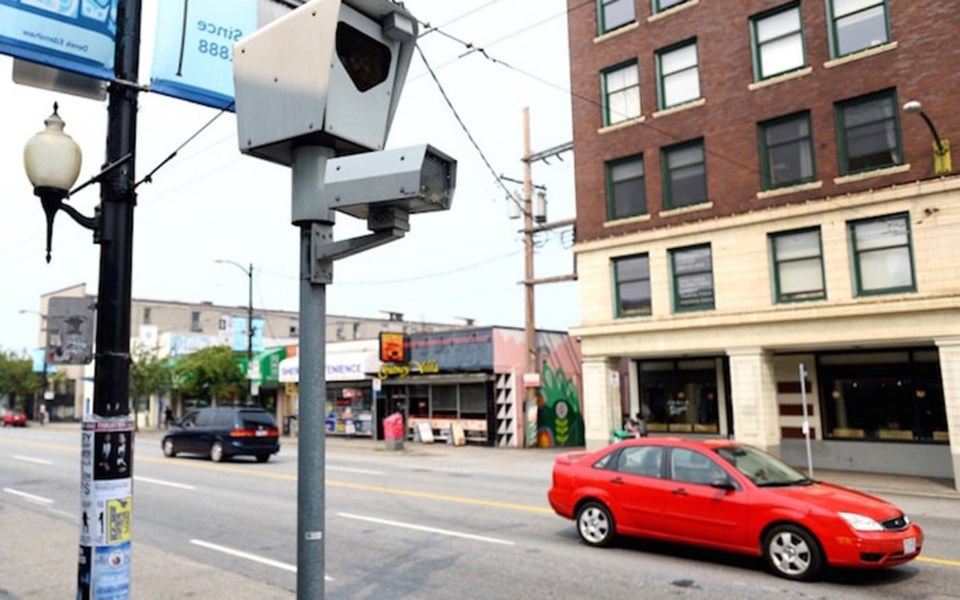Recently, the government of Alberta announced its intention to phase-out the use of “photo radar” across the province. The goal is to reduce the number of sites where automated speed enforcement is used from 2,200 to about 660. In the overwhelmingly populist slant of the current provincial government, Transportation Minister Devin Dreeshen delivered the news in an apron emblazoned with the words “Cash Cow.”
In 2019, almost two decades after the provincial government under BC Liberal premier Gordon Campbell eliminated “photo radar,” intersection safety cameras began to operate in British Columbia once again. Right now, 140 different devices monitor high-risk intersections, looking for red light and speed violations.
The concept of speed-on-green intersection cameras, or red light cameras that also capture vehicles that are speeding through intersections, remains popular across the province. More than seven in ten British Columbians (72 per cent, down one point since November 2023) approve of their use. This includes majorities of residents who voted for the BC NDP (76 per cent), the Conservative Party of BC (72 per cent) and the BC Green Party (65 per cent) in this year’s provincial election.
Plastic straws were a cause célèbre for BC Conservative politicians in this year’s campaign, but discussions about automated speed enforcement were nowhere to be found—a sign that the province has welcomed these changes, in spite of what diminutive interest groups consistently purport on social media.
This year, more than seven in 10 British Columbians are also in favour of two other types of automated speed enforcement: Fixed speed cameras, or cameras that stay in one location and measure speed as a vehicle passes (71 per cent, down two points), and point-to-point enforcement, which uses cameras at two or more distant points on a road to calculate the average speed of vehicles that pass between points and issue tickets to vehicles whose average speed over the distance was excessive (also 71 per cent, up 14 points).
The use of mobile speed cameras, or cameras that can be moved from place to place to measure speed as a vehicle passes, is approved by 64 per cent of British Columbians (down one point).
British Columbians are noticing speeders away from specific intersections. Seven in 10 say they perceive a vehicle going over the current speed limit of 50 kilometres per hour “at least once a day” (40 per cent) or “a few times a week” (30 per cent).
A few years ago, Vancouver City Council unanimously passed a motion to establish a pilot project that saw the speed limit reduced to 30 kilometres per hour on select residential streets in the city. Just over two-thirds of British Columbians (67 per cent, down two points) think this is a “good idea.” Residents of Metro Vancouver are particularly satisfied with this approach (70 per cent), but majorities in Southern B.C. (69 per cent), Northern B.C. (66 per cent) and Vancouver Island (61 per cent) and the Fraser Valley (56 per cent) also laud the idea.
When asked if their municipality should follow Vancouver’s lead and reduce the speed limit to 30 kilometres per hour on all residential streets, while keeping the speed limit on arterial and collector roads at 50 kilometres per hour, more than three in five British Columbians concur (63 per cent, up two points) while only 29 per cent (down three points) are opposed.
Support for the implementation of a reduced speed policy is high across all three age groups: 62 per cent among British Columbians aged 18 to 34 and aged 55 and over, and 64 per cent among those aged 35 to 54.
This year’s survey shows that the appetite for slower speeds on residential streets has not subsided in British Columbia, and support for automated speed enforcement remains high across the province. At a time when the provincial government is looking for renewed collaboration with municipalities on issues such as housing and infrastructure, the public would welcome policies to reduce the nuisance—and law-breaking—of speeders in residential areas.
Mario Canseco is president of Research Co.
Results are based on an online survey conducted from Nov. 27-29, 2024, among a representative sample of 801 adults in B.C. The data has been statistically weighted according to Canadian census figures for age, gender and region in B.C. The margin of error is plus or minus 3.5 percentage points, 19 times out of 20.




